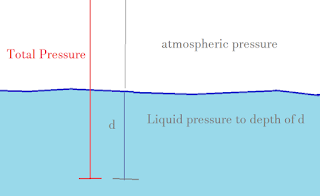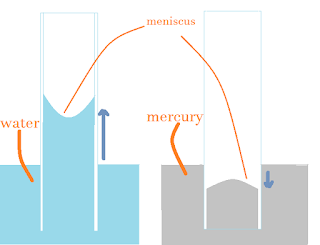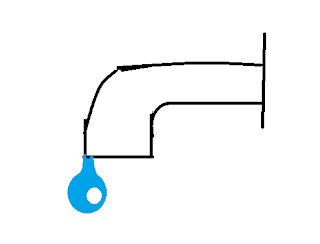Static Fluids
Fluids are substances that continue to share when presented with any amount of tangential force. They include liquids and gases. They also include some substances you wouldn't normally include as liquids or gases. Such substances as paste that flow constantly but very slowly.
Standing Pressures
When there is a column of water in a tube, that column of water exerts pressure on the bottom of the tube. The pressure is due to gravity. You can view the column as a little pillar of solid material. Its weight is pressed on the table.
This pressure is evident in seas and in water tanks. Submarines needs to be specially designed to go beyond certain depths in the water. If a vessel goes too deep it might burst if not designed well enough.
The atmosphere also weighs on us like we were carrying a column of light weights up into the upper layers of the atmosphere. Our blood pressure matches this atmosheric pressure. In space astronuats have to wear pressurized suits so they don't burst open because their blood pressure will be under-matched. Very deep under the sea divers wear armored suits that has an inside pressure equal to sea level values so they don't implode.
How It All Counts Up
Refer to the diagram above. In a tube of diameter d and height h and if the liquid has a density p, the mass is
M = p x volume = p x d2(pi)/4 x h
The weight is
W = M x g
Where g is the acceleration due to gravity. Assuming the base of the tube were flat, and the height of the tube was h Pressure on the base is
P = W/A, where A is the area of the base.
Now, this pressure calculated is valid for any height even if the fluid was not in a thin tube. You can see this because
A = d2(pi)/4, therefore the pressure P
P = p x h x g.
Pressure is only dependent on height of the fluid and gravity apart from the density. Now one must take into account the
atmospheric pressure. So the total pressure is
PT = atmospheric pressure + P
Climbing Up Walls on Spidee's Fingers
When you some things together the acquire a static charge that causes the to attract or repel other substances. Materials have some attraction to each other. The particles that make up a material can be more attracted to each other than to particles of other substances or they may be more attracted to the particles of another material than to each other. Grease is harder to wash off than dust using water because grease is not attracted to water more than itself and it is more attracted to the palms than water or dusts.
Water sleeps on glass because it attracts glass that it attracts to itself. The attraction a body has to a different type of body is called adhesion. The attraction a body has to itself is called cohesion. So water has more adhesion to glass than cohesion.
Adhesion
Adhesion is the force of attraction between molecules of different matter. For instance the force of attraction between water and glass is called 'the adhesion of water to glass'.
Cohesion
Cohesion is the force of attraction between molecules of the same matter. For instance the force of attraction between molecules of water is called the 'cohesion of water'.
Drags and Push Offs
Refer to the diagram below
Some matter may have more adhesion for other stuff than cohesion. One example is water and glass. Water will sleep on glass and it is often seen sticking to it if it were run off. Another example is oil on the floors or on glass. You find it had to clean oil-stained glass even with detergents because it has a lot of adhesion to it.
There are also instance, where a material is more cohesive than it is adhesive to another substance. One example is mercury and glass. Mercury forms balls on glass as if it were avoiding it. If you run mercury off glass it almost all runs of the glass except if probably there were stains or deformities that may cause some of it too stick.
Capillarity
When a fluid is put in a thin capillary tube made from glass it either pushes up or fall in depending on whether it is adhesive or cohesive to glass. In the case of water it starts pushing itself up and also forms a concave meniscus at the top. This is because the center can't touch the glass but the edges do. The edges act like it was holding on to the glass. Refer to the diagram below:
If you pour mercury it dips in. The edges fall in while the center forms a convex area at the to or the meniscus. The mercury is more cohesive than it is adhesive to glass so it's sides sort of rather fall inwards than be sticking with the glass.
Surface Tension
Fluid that is very cohesive would seem to have a stretchable surface. Very sticky liquid would even feel elastic when touched. Because of the cohesiveness being much a fluid would form balls in droplets or when on surfaces. Water for instance has some cohesiveness and you will find droplets stretching downwards into a droplet form.
There are insects that take advantage of surface tension
- Pond Skater
- Mosquito Larva
- Some spiders( I hear )
Breaking the Skins
To reduce surface tension, a foreign substance is added to perhaps reduce the cohesiveness or the temperature is increase. Usually you can use oil, kerosene, camphor, alcohol, detergent or soap etc.
Density
Density of a fluid and its relation to solids is treated in Density





No comments:
Post a Comment